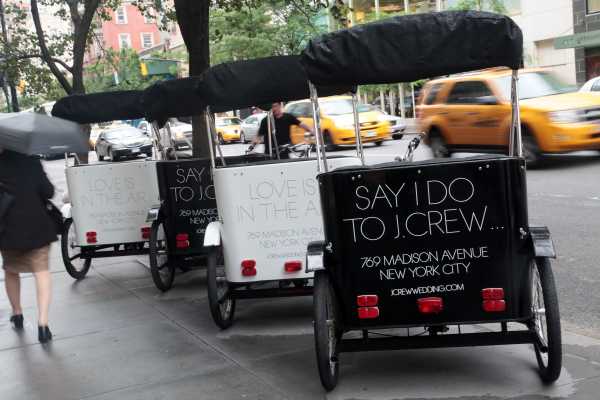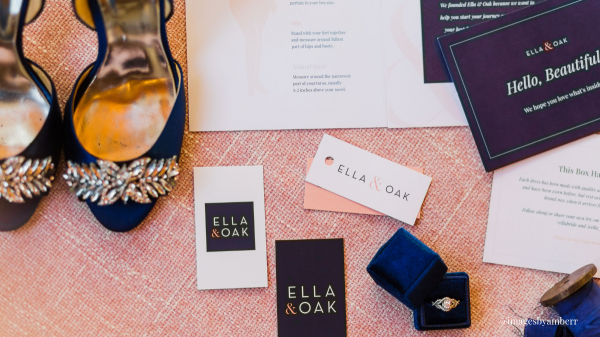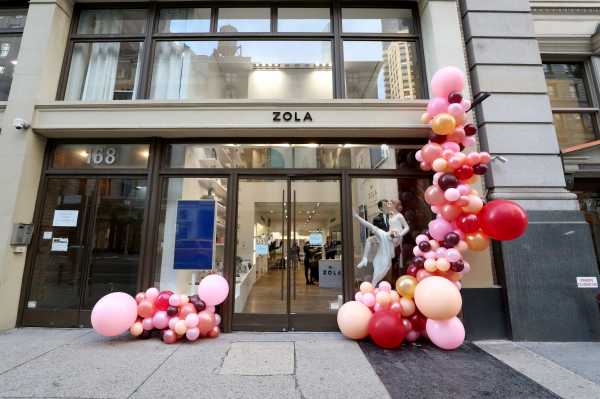 ?” alt=”Why is the wedding industry so hard to disrupt?” />
?” alt=”Why is the wedding industry so hard to disrupt?” />
Why is the wedding industry so hard to disrupt?
Weddings are big money — but not for Silicon Valley.
By
Kaitlyn Tiffany@kait_tiffany
Mar 1, 2019, 2:50pm EST
Share
Tweet
Share
Share
Why is the wedding industry so hard to disrupt?
tweet
share

Zola, the e-commerce platform reinventing wedding registries by allowing couples to register for products from hundreds of brands — as well as for “experiences” or cash — is the first successful wedding industry startup since the founding of the wedding-planning website the Knot in 1996. It’s currently worth $650 million, following a new $100 million funding round led by Comcast Ventures, NBCUniversal, and Goldman Sachs. It’s the first successful tech startup in the wedding space ever.
In its first year, 17,000 couples signed up to do their registries through Zola, a number that looks mildly to not impressive on its face but has been spun compellingly in the press by CEO and co-founder Shan-Lyn Ma: Last spring, she told TechCrunch, “One hundred and fifty people on average see [a wedding’s] registry, and if those visitors believe it’s a better product, [they come to us, too]. It’s built-in virality.” By press time for that piece, 500,000 couples had used the service, proving her math.
In the wedding industry, there is supposedly plenty of money to go around: $3 billion a year in the US, and $72 billion globally. According to The Knot’s annual survey, the average wedding in 2017 cost $33,391, a slight dip from $35,329 in 2016, but still more than half of the median annual household income in the United States. If there is one thing that anyone knows about weddings, it’s that people spend a lot of money on them. If there is one other thing that anyone knows about weddings, it’s that all that money is basically lost to the air, disappearing after its handful of hours in the sun. The ephemerality of that cash has plagued the wedding startup space too.
Lover.ly, the wedding planning site and app launched in 2011 with $7 million of venture capital, debuted a failed e-commerce project in 2015, then pulled its app from the App Store and laid off its entire staff but two people in 2017 (four months after a New York Times profile!). Today, it’s a blog. The bridal party coordination and dress manufacturing startup Weddington Way was acquired by the Gap in December 2016, and shuttered less than 18 months later. The Santa Monica-based bridesmaid dress rental startup Vow to be Chic raised $2.5 million in January 2018 and went out of business four months later. The nearly identical New York-based Union Station is still kicking, but it just sells the dresses now, in a range of colors and cuts, made to order based on measurements. You know, the way bridesmaids dresses have typically been sold.
There’s a lot of money in weddings; there’s been a lot of money lost in wedding startups. Why is it so hard to disrupt the wedding industrial complex?
“Some investors believe maybe there’s something inherent to the industry that means a big company can’t be created,” Ma tells me when I ask why her company is really the only one. “There have been some VCs that have invested in wedding startups that then closed, so they swore off weddings as a category.”
“There have been some VCs that have invested in wedding startups that then closed, so they swore off weddings as a category”
To some degree, the notoriously rigid wedding industry has shifted and bent in the internet age. Wedding planning, for example, has moved online. Pinterest says 40 million people use it to plan a wedding every year. Condé Nast is trying to offload the iconic print magazine Brides — credited with creating the tradition of the five- or six-figure American dream wedding in the first place — while Harper’s Bazaar is betting that it can charge $90 for 12 installments of a wedding planning email newsletter, featuring one missive from Vera Wang.
The Knot, which respawned as an umbrella company called XO Group in 2011, is worth more than $900 million, growing even as it’s forced to pivot away from a pageview-driven media model as well. But much of that growth comes from old-school industry clout. The company swallowed up its main competitor, WeddingWire, last September, and when I ask chief marketing officer Dhanusha Sivajee if she sees any startups doing anything interesting in the space, she responds breezily, “We’ve purchased the ones that are doing things we think are unique and different.” (That includes, most recently, the photo-sharing app Veri, acquired for $3.5 million in 2017. It was once a $100 download and is now offered as a free perk to The Knot customers.)
Modern couples interested in ease, or sharing, or the handmade have bolstered plenty of wedding-tangential businesses. Etsy tells me there are more than 24,000 custom wedding dresses for sale on the platform at the moment, as well as 25,000 custom engagement rings and 32,000 custom save-the-date cards. The Urban Outfitters-owned Anthropologie and the Walmart-owned ModCloth have affordable wedding lines now. Yet J.Crew’s attempt at mass-market bridal went belly-up, and David’s Bridal foundered even after elaborate and expensive efforts to rebrand as something other than “the Walmart of weddings,” declaring bankruptcy last year. In other words: You can spit and hit a failed wedding disruption plot.

“I would definitely avoid the wedding industry,” web designer Tracy Osborn tells me, a few weeks after shuttering her nine-year-old business WeddingLovely.
Osborn started WeddingLovely in 2010 as a wedding industry blog and suite of ad-free planning tools as a side project, just to teach herself how to code. But when it started to get popular, Bay Area investors eyed it with interest and she took $75,000 in investment. There was interest in an acquisition by Etsy, which fell through, and cost Osborn the momentum she needed for a larger funding round. She ran the business alone for three years — competing, miraculously, with industry heavyweight the Knot — creating a blog with incredible search traffic and building out a directory of wedding-related businesses that would pay for placement.
In March 2018, she tried to sell the business simply because it was making plenty of money and she didn’t really feel like running it anymore. She made her case to possible buyers in an in-depth Medium post, providing site traffic, financials, and suggestions for further growth.
That summer, she says, Google tanked WeddingLovely. Search engine optimization “giveth and taketh away,” she tells me, laughing gamely at the unpredictable whims of algorithm that undergird both of our livelihoods. “Our SEO dropped for some reason. I wasn’t able to sell the business for what I wanted, because WeddingLovely was losing traffic, and what I was doing wasn’t working.” She realized there simply wasn’t a sustainable, growable audience for a wedding website.
Even though there are 2 million weddings per year in the US alone, that is actually not enough click-throughs to sustain a business
Osborn says she has no idea what’s going on in the broader industry because she doesn’t pay attention anymore; she’s too annoyed. She would like to point out that if you sign up for the Knot, you receive paper advertisements from wedding-related businesses for years. “They’re selling that sign-up, saying, ‘Hey, advertisers, this person’s getting married.” She would also like to point out that even though there are 2 million weddings per year in the US alone, that is actually not enough click-throughs to sustain a business. And even though those weddings are worth north of $30,000 on average, this money is capricious.
“A lot of startups will see those numbers and think people are just throwing money around, they get dollar signs in their eyes,” she says. “But it’s approximately a year between someone getting engaged and having their wedding, and then they move on with their lives. They forget that their customers leave after a year and they have to get a whole new set of users.”
“I eloped in Vegas. I didn’t want to have a wedding after seeing everything that goes into a wedding,” Osborn says. “I wanted to make it more holistic and less consumerist, but it’s really hard to change that at a large scale.” Now, she’s perfectly happy writing introductions for coding textbooks, nurturing her web design business, ignoring the flops and triumphs of the “disruptors” wandering each day into the wedding industry wave pool.
Much of the disruption in the space has been in response to the desire to rent or borrow glitzier weddings than couples can afford to buy outright: Bloomerent lets couples having their weddings in the same weekend in the same city split the cost of flowers and reuse them. Nearly Newlywed lets brides wear lightly used designer gowns. It’s the same motivation that drives Ella & Oak, which describes itself as “Warby Parker meets Rent the Runway,” and sends out boxes of sample dresses for brides to try on at home.
Where many DTC brands suffer from the cost of shipping and returns, the New York-based direct-to-consumer wedding dress brand Floravere — tagline “The bridal revolution is here” — says sending out samples and having brides try on dresses at home actually eliminates a lot more issues than it creates. It gives customers way more than an hour to make a purchase decision, which makes them less likely to regret it. Plus, super-trendy-looking gowns with names like “J. Didion” and “J. Lawrence” (and “M. Curie” and “A. Earhart”) can go for the same price as something you would find at a big-box store.

Aspirational outfitting was the goal with the bridesmaid dress rental startup Union Station too, but it found the limit to this value-driven, savvy customer. Centered on its website a year after launch was an apology for the failure of its rental proposition: “Our mission is — and will always be — to treat your friends like they’re our friends. Being a good friend means being honest with you. And to be totally honest, renting just wasn’t working.”
Founder Corie Hardee tells me that, as it turned out, renting a bridesmaid dress only stressed people out around a high-stakes day. “You get the dress right before the wedding; oftentimes, somebody needs alterations,” she says. “About a year ago, we switched the business model to just selling bridesmaid dresses. But we’re still cutting out the store.” Union Station will have no public investment round and is still working on pivoting its business model, having secured a New York City factory to manufacture its dresses.
More than half of the average wedding budget is spent on a venue. The second-biggest expense is the band. Then the photographer. Are you going to disrupt the basic physical facts of buildings and contracted labor? I hope not. That kind of thinking has already gotten us into a lot of other sticky situations.
Zola CEO and co-founder Shan-Lyn Ma is still making the rounds in tech-centric business publications, patiently explaining that her success was basically just a feat of timing. The company would not have worked if the idea hadn’t arrived at the same moment as widespread drop shipping — the practice of acting as a middleman for online orders, used nefariously by shady companies on Amazon and Refinery29 “Money Diary” villains, but a legitimate business practice in this case. The year Zola started was the same one most home brands started opening up their own e-commerce platforms to ship single items, which made it possible for a company to offer the ability to purchase everything a young couple could want, without actually holding an inventory of anything.
It would not have worked if millennials didn’t have such an interest in experiences, such a shortage of cash, such a habit of living together before marriage and not needing stuff. It would not have worked if she hadn’t found needle-in-the-haystack investors who would even bother to invest in a wedding startup.
The wedding industry is driven primarily by “female decision-making and spending”
The real secret to Zola’s success is probably even more banal than that: Though only about 2 million people getting married each year in the US, close to 70 million people will attend a wedding, and a recent NerdWallet survey suggests they’ll spend more than $100 on a gift. (Millennial men spend the most: $180 for a close friend.) Rough math? That makes wedding gifts a more lucrative industry than weddings themselves, and a much simpler one.
Ma heard from plenty of possible venture capital investors that because there hadn’t yet been a huge company or lucrative exit in the space, there wasn’t much interest in betting on one now. The wedding industry is driven primarily by “female decision-making and spending,” she tells me, and these women are also 20 to 30 years younger than the average investor. “That adds another layer of difficulty.”

“Even in the short five years since I started Zola, there’s been a lot of turnover of companies and startups in this industry,” Ma says. “There have certainly been startups in the wedding industry that have quickly spread and gained users, and garnered attention, but they didn’t have a great way to stay in business or generate strong, fast-growing revenue, so ultimately didn’t have a way to survive.”
Asking people to pay $50 to use an app that only allows them to plan one portion of their wedding doesn’t work. Relying on advertising doesn’t work either: “[There’s] a natural cap. There’s never that many eyeballs,” Osborn says. And weddings are a uniquely tricky business — not because of bridezillas or the involvement of government and God, but because every marketing dollar you spend acquiring a customer has to be spent again the following year.
Jackie Courtney, founder of the designer wedding dress consignment platform Nearly Newlywed, echoes Ma, and adds that traditionally, companies like David’s Bridal have counteracted the cost of acquiring new customers every year by jacking up prices.
“You try to get them to buy more stuff — two dresses, accessories — and that’s how bridal businesses try to offset the fact that you’re fundamentally dealing with a customer for a limited period of time,” she says. Even if that pisses off a customer, it doesn’t especially matter. This is only a process they have to go through once.
“If I were buying sneakers, I would at a certain point decide I’m going to stop buying sneakers in this clunky way; it doesn’t make sense”
“If I were buying sneakers, I would at a certain point decide I’m going to stop buying sneakers in this clunky way; it doesn’t make sense,” Courtney says. “But the dress shopping business … I just want to get my dress and have my wedding and then I’m done with this. There’s less pressure of innovation.” There’s even less pressure of innovation when the people writing investment checks see the whole affair as a series of unshakable stereotypes.
If Zola has any real competition for the wedtech throne, it’s going to come from a pretty expected, entrenched place: the Knot, which was taken private by Permira and Spectrum Equity, paying out $933 million to shareholders. “I think the fact that we were acquired at the beginning of this year for close to a billion dollars shows there’s a lot of potential in the space,” Sivajee argues, saying she’s willing to offer a counterpoint to my entire article. In the past five years, the Knot has gone from a media-based business model to a “media-to-marketplace” model that still uses ads but also connects couples to wedding vendors and registry brands. “Our stock price has increased 18 percent; that’s directly because we’ve taken a media company and turned it into a tech company.”
The Knot isn’t Zola’s competition if you ask her. Zola is competing with Bed, Bath & Beyond, and with Macy’s. The Knot is “aggregating all of those players.”
The Knot is, in her mind, “the uber wedding planner.” Sexism holding back the wedding tech industry? Sivajee doesn’t see it. After all, 30 percent of the Knot’s product and engineering team is women. That’s much higher than “the Facebooks of the world,” if nowhere near equality. She’s pretty happy about the way things are going. In her view, the wedtech industry is going to be just fine.
Want more stories from The Goods by Vox? Sign up for our newsletter here.
Sourse: vox.com






